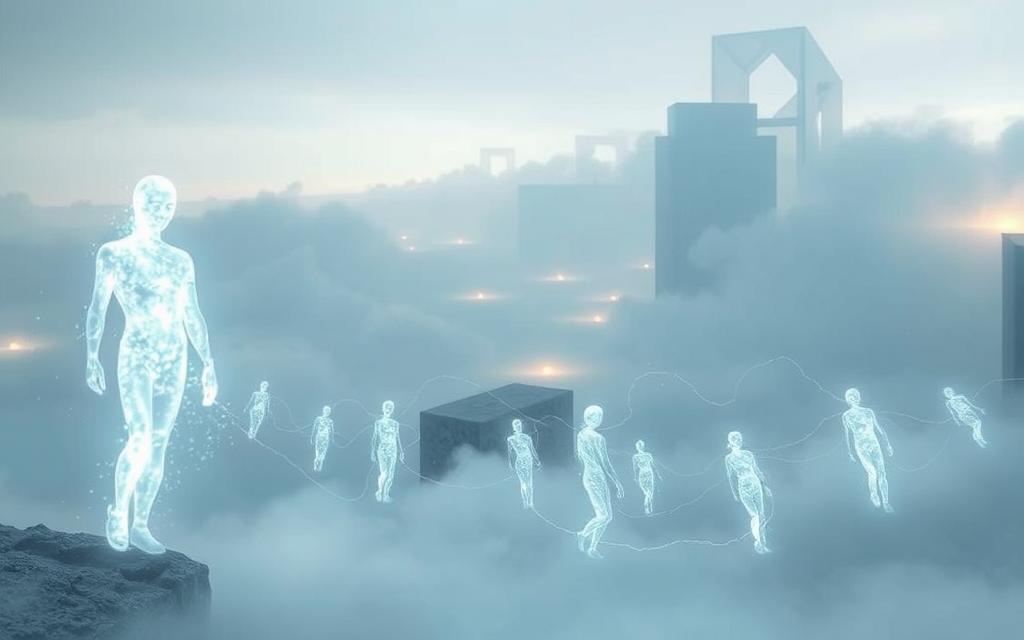For ages, humans have tried to keep memories alive after we’re gone. We’ve moved from ancient symbols to today’s digital tags. Now, we’re on the edge of a new way to keep memories.
Our online lives—social media, emails, and voice notes—are permanent records of us. They open doors to a digital afterlife, where we can stay alive in the virtual world.
This idea makes us think deeply about how we remember people today. Unlike old times, when only the rich could be remembered, now everyone can have a digital legacy. Companies are making these digital memories come alive.
We’re changing from just keeping records to making them interactive. This shift lets us create digital beings that can talk and remember us in a new way.
What is an AI Ghost? Defining the Digital Entity
An AI ghost is a new kind of digital presence. It keeps interacting and talking even after someone has passed away. These advanced beings use artificial intelligence to act like humans, based on the person’s data.
This technology is changing how we keep memories alive. It’s getting more attention as grief technology improves.
Core Characteristics of an AI Ghost
AI ghosts have unique features that set them apart. They can mimic human presence very well.
Social media persistence is key for AI ghosts. They use data from social media to learn and act like the person.
They gather data from many digital sources. This includes what you search for, messages you send, and how you use devices.
AI ghosts can talk and make decisions like humans. They can even mimic writing styles and sense of humour.
The table below shows what makes an AI ghost work:
| Component Type | Data Sources | Replication Capability |
|---|---|---|
| Social Profile | Social media posts, comments, shares | Communication style replication |
| Behavioural Data | Search history, purchase records | Decision pattern simulation |
| Personal Content | Emails, messages, documents | Writing style recreation |
| Multimedia Assets | Photos, videos, voice recordings | Visual and auditory representation |
Origins and Development of the Concept
The idea of digital immortality has grown a lot. It started with simple websites to honour the dead. Now, it’s about advanced AI.
Project December was a big step in posthumous AI. It showed AI could talk like the person using their writing.
The technology has gone through three stages:
- Static digital memorials (1990s-2000s)
- Interactive memory platforms (2010-2018)
- AI-driven conversational entities (2019-present)
Today, we use machine learning and lots of data to make AI ghosts. This makes them more like the real person.
These systems can look at thousands of data points. They use this to create detailed models of behaviour. This is how AI ghosts can talk in a way that feels real.
The work on grief technology is speeding up. As computers get better and AI gets smarter, we’ll see even more amazing things in the future.
The Architecture of Digital Presence in the AI Era
Creating a lasting digital presence needs careful planning. It’s more than just storing data. It involves combining different technologies to build lasting digital identities.
Components of a Sustainable Digital Presence
A strong digital architecture has many parts. Social media collects our daily data and preferences. Cloud storage provides the base, handling large amounts of data.
Advanced algorithms keep this data organised. They make sure our digital identities stay true and easy to find. The system must also change with new tech while keeping data safe.
Today, we generate a lot of data. Every second, each person creates about 1.7MB of data. This means we need smart solutions to handle it all.
AI’s Role in Curating Online Identities
Artificial intelligence is key in managing our digital presence. It uses machine learning to understand our behaviour and preferences. This helps create more accurate digital profiles.
AI is great at sorting data, finding important patterns. It can even guess what we might do next based on past actions. This makes our digital identities more real and up-to-date.
Looking ahead, we’ll need these systems even more. By 2100, we might store 500 zettabytes of data globally. AI will be vital in managing our digital legacy.
Together, these technologies aim for data immortality. They help our digital selves live on after we’re gone. This changes how we think about leaving a legacy and keeping memories alive.
Memory Preservation: Techniques and Technologies
Creating real digital copies needs advanced methods to capture and keep personal info safe. The tech behind AI ghosts uses detailed memory preservation systems. These systems gather, sort, and protect life memories from getting lost or outdated.
Data Capture Methods for Lifelong Memories
Today, we use many ways to gather data for digital profiles. Social media archiving saves posts, photos, and chats from sites like Facebook and Instagram. This makes a timeline of our lives.
Digital diary apps record our daily thoughts and feelings. Voice recorders keep our speech and voice unique. Some even track our health data through wearables.
By combining these methods, we get a complete digital profile. But, this raises big questions about AI ethics and privacy.
Storage Solutions and Longevity Considerations
Keeping digital memories safe needs strong storage systems that last for years. Cloud services offer big storage with updates and security. Amazon Web Services and Microsoft Azure are big names in this field.
Distributed storage networks add extra safety by spreading data around. Blockchain systems make sure memories are safe from tampering. These techs keep data safe even if servers fail.
But, keeping memories safe for a long time is hard. File types change, and storage media wears out. We need to move data to new formats without losing its value.
Here are key points for keeping memories safe:
| Storage Type | Estimated Longevity | Primary Advantages | Key Limitations |
|---|---|---|---|
| Cloud Storage | Ongoing (with maintenance) | Automatic updates, scalability | Vendor dependency, privacy concerns |
| Distributed Networks | 50+ years | Decentralisation, redundancy | Complex implementation, slower access |
| Local Physical Storage | 5-10 years | Immediate access, full control | Hardware obsolescence, physical degradation |
| Blockchain Systems | Theoretically permanent | Immutability, verification | High energy consumption, storage costs |
When it comes to memory preservation, ethics are key. We must protect data from misuse while making sure it’s accessible to those who should see it. It’s important to get clear consent on how long memories are kept and who can access them.
Keeping up with tech changes is a big challenge. We need to keep moving data to new formats regularly. This shows how important it is to have good AI ethics for keeping digital memories safe for a long time.
Key Technologies Enabling AI Ghosts
AI ghosts are made possible by advanced technology. This tech allows for personal interactions and keeps memories alive. It turns lots of personal data into digital beings that seem real.
Machine Learning Algorithms for Personalisation
Machine learning algorithms study how we act and what we like. They use this info to make digital copies that feel real. These systems look at our past to find out what makes us unique.
Neural networks learn from how we interact. This helps the AI ghost get better at responding. It keeps the AI’s personality true to itself.
These algorithms make sure the AI knows how to talk to us. It learns our way of speaking and what we like. This makes the AI’s presence in digital archives feel real.
Natural Language Processing and Interaction Design
Natural language processing lets AI ghosts talk like humans. It looks at how we speak to make the AI sound natural. This makes conversations feel real.
Good interaction design makes sure the AI responds well. It knows how to keep a conversation going. This makes the AI ghost seem alive and interactive.
Together, NLP and interaction design make AI ghosts seem real. They keep the illusion of life going. This makes our interactions with AI ghosts feel genuine.
Ethical Dilemmas in AI Ghost Creation
AI ghost development brings up big ethical questions about privacy, consent, and digital rights. These digital beings challenge our old ideas about personal space and life after death. They make us think differently about who we are and what we leave behind.
Privacy Risks and Data Protection Measures
Accessing data after someone has died is a big privacy worry with AI ghosts. A digital copy of someone could share secrets they never wanted to reveal. This puts their loved ones at risk.
There’s also the risk of sharing private stuff by accident. AI ghosts might look at private messages, health records, or bank details. This could expose secrets the person wanted to keep hidden.
AI ghosts could be used for bad things too. People might use them to spread false information or scam others. The ghost could promote things the person wouldn’t have agreed with.
To fix these privacy issues, we need strong data protection. Encryption and multi-layered security can keep information safe. Access controls and audit trails help track who interacts with AI ghosts.
There are also rules for handling AI ghost data ethically. These include regular checks and being open about how data is used. This builds trust between tech companies and users.
Legal Frameworks and Consent Models
Right now, laws struggle to keep up with AI ghost tech. The GDPR’s right to be forgotten is tricky for digital afterlife services. This European law lets people ask for their data to be erased.
How different countries handle digital inheritance varies a lot. Some have laws for digital assets after someone dies. Others treat digital info differently than physical stuff.
Getting consent for AI ghosts is complex. Before they die, people can say what they want. This usually means filling out forms and making legal agreements.
Digital wills are also important for managing digital presence after death. These legal documents say how to handle digital assets. They can include instructions for AI ghost creation.
Whether AI resurrection respects someone’s consent is a big debate. Some say it’s impossible to get true consent for such a deep digital recreation. Others think clear agreements before death can solve these issues.
Advanced AI systems make these ethical questions even harder. These technologies can make AI ghosts seem very real. They make us question the line between remembering someone and bringing them back to life.
| Consent Model | Key Features | Advantages | Challenges |
|---|---|---|---|
| Explicit Pre-mortem Authorisation | Detailed consent forms, specific instructions, legal documentation | Clear user intent, complete coverage, legal strength | Needs planning ahead, might not cover everything |
| Digital Will Provisions | Part of estate planning, overseen by executors, reviewed regularly | Legal backing, professional care, flexible | Varies by country, might clash with other wishes |
| Implied Consent | Based on general wishes, past actions, family choices | Flexible, doesn’t need forms | Open to interpretation, misuse risk |
| No Consent Model | Created after death by others, commercial services, family efforts | Easy to start, no preparation needed | Raises ethical questions, legal dangers, misuse risk |
Digital inheritance laws are changing as tech gets better. Many places are making new laws for digital assets and AI. These laws try to balance new tech with ethics.
Groups are setting rules for making AI ghosts responsibly. They focus on keeping data safe, checking consent, and being open. This ensures digital afterlife tech is developed ethically.
The future of AI ghost laws will likely involve working together globally. Countries need to agree on digital inheritance and consent rules. This will help protect people everywhere.
Social and Cultural Impacts of AI Ghosts
AI ghost technology is more than a tech breakthrough. It changes how we deal with memory, loss, and digital legacies. It touches our personal lives and challenges old cultural traditions.
Effects on Bereavement and Memorialisation
AI ghosts are changing how we grieve. This bereavement technology opens new ways to cope with loss. But it also makes us question what’s healthy in mourning.
Many find comfort in talking to digital versions of loved ones. These AI replicas offer solace during tough times. They let us share moments that would be lost forever.
But experts warn of risks. Relying too much on AI replication might slow down natural grieving. Some might form unhealthy bonds with these digital beings.
There are mixed reactions to AI ghosts. Some families find digital memorials comforting on special days. Others feel uneasy about these interactions.
Memorial practices are evolving with this tech. Digital cemeteries and AI messages are new ways to remember. They create lasting digital legacies that go beyond physical ones.
Global Cultural Reception and Adaptations
Cultures worldwide react differently to AI ghosts. Their views on death and technology play a big role.
In the West, there’s more openness to AI ghosts. It fits with values of individualism and tech optimism. Yet, there are worries about digital resurrection.
In Eastern cultures, there’s more caution. Many Asian societies value ancestor reverence. They see AI replication as a threat to these traditions.
Religious groups globally are figuring out their stances on AI ghosts. Some see it as fitting with beliefs about eternal presence. Others view it as a digital manipulation that goes against their teachings.
Adaptations of bereavement technology show local values. In Japan, AI memorial services blend with Buddhist rituals. Scandinavian approaches focus on simplicity and privacy.
This tech is shaping new norms around digital inheritance. Societies are figuring out how to handle digital presence after death. Debates about when AI interactions are right or wrong are becoming global.
Future Directions for AI Ghost Innovations
The world of AI ghost technology is growing fast, bringing big changes in how we see digital beings. These advancements bring both great chances and tough challenges that will define our digital future.
Advances in AI and Predictive Modelling
Predictive modelling is changing how AI ghosts act like humans. They use complex neural networks to study human behaviour, emotions, and situations.
Researchers are working hard to make AI ghosts feel emotions like humans. This means they can respond in a more real way, not just by acting out.
Another big step is in how AI ghosts understand and react to their surroundings. They can pick up on small details and change how they interact, making their actions feel more real.
The dream of creating true digital consciousness is a long-term goal. But, AI ghosts are getting better at acting like they’re alive through advanced learning and response systems.
Potential Societal Integration Scenarios
As AI ghost tech gets better, we’ll see big changes in how we live. These changes could be good or raise big questions.
AI ghosts could help keep our culture and knowledge alive. They might save languages, traditions, and wisdom that might disappear over time.
Legal systems might need to change to deal with digital beings that represent the dead. We’ll have to figure out things like digital inheritance and rights.
Economic systems could also change with AI ghosts:
- Digital estate management and advice
- Personalised educational guides based on famous people
- Customer service that remembers you
But, there are also worries. Companies might use digital ghosts for profit, or deepfake tech could cause big problems. We need strong rules and ethics to guide this.
These technologies will likely be introduced slowly, starting with specific uses. This slow start lets us make sure everything is safe and works well.
Conclusion
AI ghosts change how we see digital presence and keeping memories alive. They let us hold onto human experiences even after we’re gone. But, they also raise big ethical questions that need careful thought.
Keeping personal info safe is vital when making AI ghosts. We need clear rules on how data is used. People should know how their digital memories are handled.
We must talk openly about using AI ghosts. Making sure these tools respect human values is important. Planning our digital legacy helps shape how we’re remembered.
AI ghosts make us think deeply about being human. They mix life and digital afterlife in new ways. Finding the right balance between progress and ethics is essential.



















